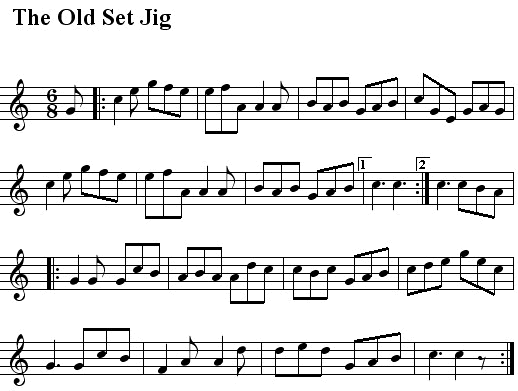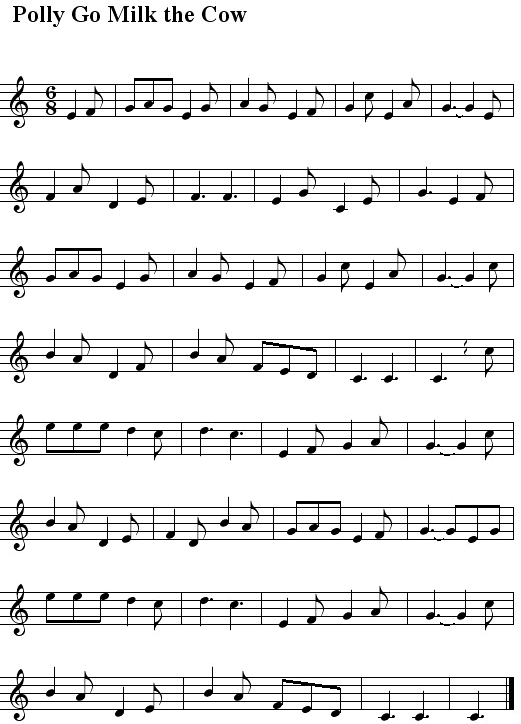
 |
|||||||||||||
In Row TUNES |
|||||||||||||
 |
The fingering given here is the basic home position. The fingers index, middle, ring correspond to the first three buttons on the G row right hand. 3 means play the third button while closing (on the push) the bellows and 3^ means play while opening (on the pull) |
|
 |
Same finger/ button correspondence as the last tune, but with the little finger included on the fourth button. Some players avoid using the little finger due to its generally being weaker than the other three. However, perseverance will give the finger the strength to be used effectively. (Finger tapping exercises that make the little finger work harder may help.. be patient) |
|
 |
This tune uses both ends of the concertina so the fingering has L and R to distinguish left and right hands. Same finger/ button correspondence. Alan Musgrove collected this nice little dance tune from Bert Shields of Unanderra. |
|
 |
Both ends of the concertina with fingers in the usual home positions. The first pair of lines and the last pair of lines are sometimes repeated (referred to as playing AABB where each letter represents an 8 bar phrase). This tune is a great one for swinging the concertina in the second part. As you play the long notes extend your arms and move the concertina in a vertical circle. A great party trick (uses the Doppler Effect if you want to get technical!) Harry McQueen from Castlemaine was a remarkable accordion player with a broad dance music repertoire. This is one of the many tunes collected from him by Pete Ellis. |
|
 |
Mudgee Waltz uses the home finger positions. A beautiful well known waltz from the concertina playing of Fred Holland. Fred taught the tune to other musicians in the Mudgee district, from whom it was collected in variant forms. John Meredith recorded several forms and published them in Folk Songs of Australia The various forms were amalgamated into the version played at the Bush Music Club as I first learnt it from Jamie Carlin in about 1977 as published in Bush Dance. |
|
 |
A great rollicking bush song in a minor key. When playing the minor key be aware that the end notes for verse and chorus are on the pull. Try to consistently use the little finger for the high A notes. |
|
 |
This lovely three-part waltz was learnt by Sally Frost over the fence from her neighbour Annie Shaw. Annie was playing piano to accompany her young man playing the violin. The Frost family always referred to the tune as Annie Shaw's Tune. Sally Sloane (nee Frost) played a remarkable repertoire of songs and dance tunes for collector John Meredith. She was a gifted musician, playing concertina, button accordion, jew's harp, piano, fiddle, mouth organ and penny whistle. The tune fits the c row of the concertina nicely. An important dance music technique for the concertina is accentuating the rhythm. This can be achieved with a bass oom pah pah, but a more subtle method used on the long notes is to increase then decrease the bellows pressure to emphasise the count. There's no surprises with the fingering so use the home positions and work the little pinkie for the high A note. |
|
 |
Clem O'Neal played this nice little waltz learnt from his father. It fits under the fingers in the home positions. When Clem introduced the tune he said "There is a waltz, they called it Hughie's waltz. My father's name was Hughie, and he came back from somewhere and he played this. My father may have heard it on a shearing trip, and he came back and he couldn't remember it (exactly). It was played up and down the river for years after and when there was two going to play together they'd say "What'll it be?" and they'd say " Hughie's Waltz." |
|
 |
Clem O'Neal is the source of this tune. He played it on both concertina and accordion. It fits within the row and is given here in C but is just as happy in G, the performed key. The tune was transcribed by Chris Moore for the first issue of Richard Evan's Concertina Magazine which was published 1982 - 1988. "This is an old Schottische, a tune they used to play, and probably made up of several tunes. I think they used to refer to it as North Wind. However, I don't ;,, think the name matters that much." |
|
 |
A rollicking tune described by concertina player Doddy Murphy as a hornpipe. It is just the kind of tune to test the agility of both a solo step dancer and his musical accompanist. Good step dancers were few and far between and musicians who could keep up with them rare as well. It was not uncommon for a step dance to become an endurance and speed contest between musician and dancer. |
|
 |
A really nice schottische eminently suited to the barn dance. This version comes from the playing of accordionist Orley Benson who learnt it from Fred Holland. It fits comfortably in the home position using both hands. |
|
 |
A nice version of The Rose Tree from Doddy Murphy who used it for one of he figgures of the First Set. Presumably it is named for a local song that fitted the melody. The third line is substantially different. Doddy plays the first and fifth bars as shown with this triplet using R1^ L1^ R1^. It is a comfortable decoration that will fit in other tunes very nicely. |
|
 |
This tune was presented at a workshop at the National Folk Festival by Melbourne fiddler Greg O'Leary. Here it is dropped to C to suit the concertina better. |
|
 |
Also known as Off She Goes and Humpty Dumpty and Georgie Porgie this version from Doddy Murphy fits nicely in the home position and uses both hands, starting on L2. There must be more words to complete the song! |
|
 |
This jig was contributed by accordionist Ray Mulligan from the ACT. Ray leads a monthly Australian tunes session in Canberra and actively promotes Australian content at the National Folk Festival. |
|
 |
Eileen McCoy spent many years in travelling shows with husband Athol, accompanying his guitar and vocals with fiddle and leading dance tunes. The studio recording of her playing made by the National Library of Australia is an immensely valuable production. Her playing is remarkable and the variety of her tunes is stunning. This jig modified from D to C fits the concertina well. It's played across both sides starting on L2. |
|
 |
This is the first tune that needs non-home position fingering. The way this is shown is the note that first needs a different finger position is shown with the appropriate finger number. So fro example at the end of the second line to play the triplet move the first finger from the first button g to the third button d. Then fingers are in the right places to play the notes until the end of bar 10 when the first finger is relocated at the home position on the g note. Paddy Godden was living in a retirement village in Forbes when Rob Willis and I visited him. Rob was a bit nervous about his first collecting opportunity so I went along with him for moral support. Paddy played a few tunes for us and as he got into practice Rob collected more over time including this mazurka. |
|
 |
A nice lilting jig that suits concertina nicely. Rita Baker was a fiddler and though affected with arthritis she was able to play quite a range of tunes for John Meredith. The fingering position changes as shown by the f numbers as for the last tune. It is tempting to use f1 for the second change but using f2 will have your fingers right fot the rest of the line. |
|
 |
Known variously as The Spanish Waltz, My Father Was a Dutchman, They Said She Was a Virgin and so on depending on the words set to it, this is one of the ubiquitous bush tunes. This is Dooley Chapman's version as transcribed (and collected) by Chris Sullivan. It has been transposed from the F played by Dooley to the more common G.
|
|